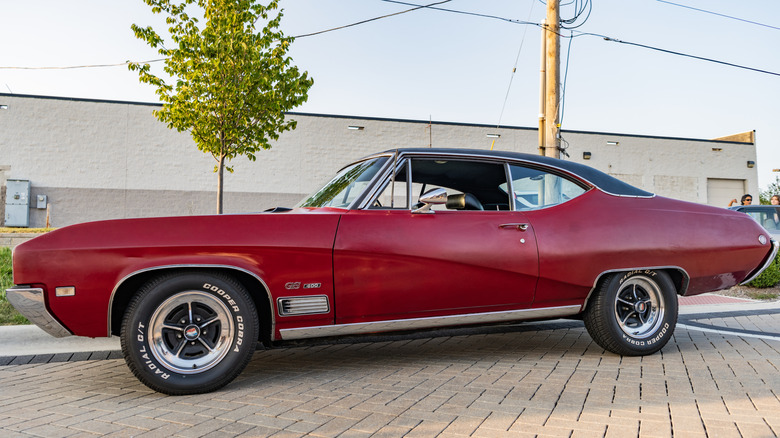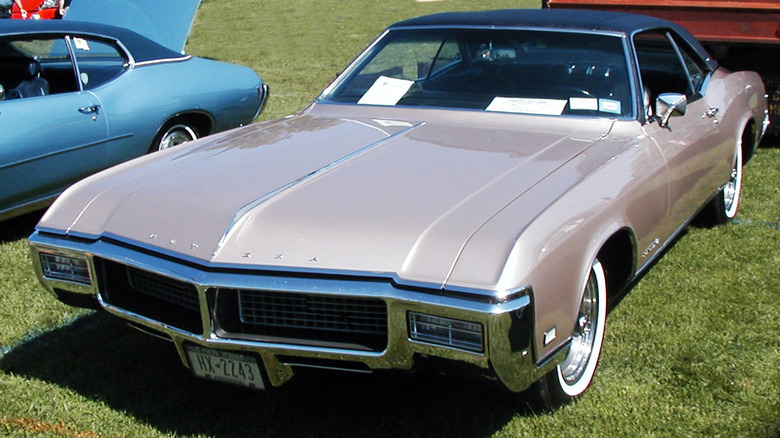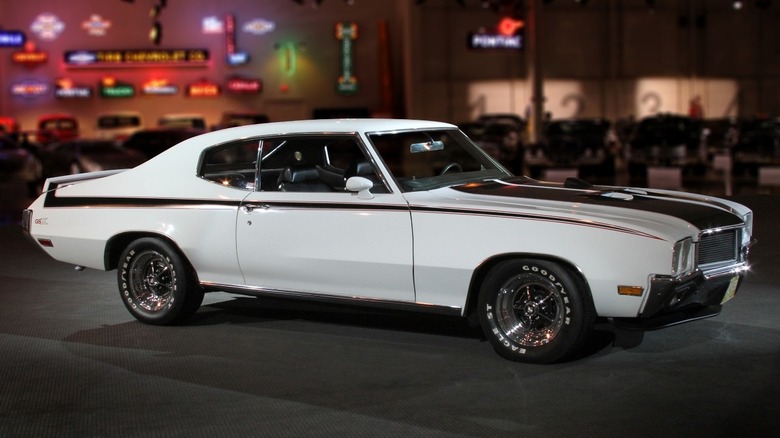5 Of The Most Powerful Buick Engines, Ranked By Horsepower
When people think of Buicks these days, typically they don't picture the epitome of performance. Arguably it wasn't since the 1980s that the General Motors branch was associated with "performance" at all, instead focusing on subdued luxury with just enough power to comfortably cruise at highway speeds. But there are a few diamonds in the rough — and some unexpected vehicles with respectable levels of horsepower among the historical and even current lineup.
There are two disclaimers before we get started. The first is that this list will only cover combustion engine-powered production cars. Buick has produced several concept cars, homologation specials, and EVs, such as the Buick Wildcat EV Concept, but these will not be counted as they either use experimental powertrains or have speculative horsepower figures. Furthermore, we'll only take the highest listed numbers for an engine; most of these powertrains came in several different cars, each of which had their own horsepower figures based on several factors like tuning.
The second disclaimer revolves around SAE net versus gross horsepower. Prior to 1971, all American production vehicles used gross horsepower as the official rating system. Gross horsepower is the horsepower of an unladen engine, so no accessories, no transmission, and so on. It's an engine on a stand, effectively. In comparison, all 1972 and later vehicles used SAE net horsepower; these figures represent the car's actual horsepower, including all the parasitic drag associated with running equipment like an alternator, A/C compressor, drivetrain, and the frictional losses of the bearings and working surfaces leading to the tires. It's basically the horsepower you get on the road and is typically around 75 to 100 horsepower less than the gross horsepower rating. So we'll calculate that into our analyses going forward — let's get underway.
400 c.i. Stage 1 V8 - 350 gross horsepower / 440 lb-ft torque
This engine was prominently featured in Buick's Gran Sport line, namely the GS 400 introduced in 1967. These cars were essentially muscular Skylarks, housing either the small block 340 or the big block 400, the latter of which produced 340 horsepower at 5,000 RPM and 440 lb-ft torque at 3200 RPM. A common theme among all these engines is that they tend to be torque monsters, likely as a result of the principle uses for such cars — they were advertised as big, roomy, but responsive muscle cars for American highways. And nothing feels responsive like a torquey punch in the back when you're overtaking at typical cruising speeds. In brochures it was known as the 400-4 due to its four-barreled carburetor; all engines with two-barreled models had a -2 suffix, so a 350-2 versus 350-4, for instance.
The 400 cubic-inch big block wasn't particularly long-lived as far as big blocks went, being replaced by Buick's 455 in 1970 across the entire model range. Its final model year, 1969, saw no changes to the horsepower rating, either, at 340 hp / 440 lb-ft with the same official RPM figures. However, that's not the end of the 400's story.
There were certain production Buick models equipped with a special 400 Stage 1 dealer-installed package, which on paper didn't do anything; the engines still officially produced the same power figures. That changed in 1969, however, with the engine receiving a 10-horsepower increase in the official ratings to 350 horsepower at 4800 RPM. It was a potent, though not overpowered, big block with enough grunt to hang with Pontiac's 400 in the '69 GTO.
430 c.i. V8 - 360 gross horsepower / 475 lb-ft torque
First produced in 1967 and supplanting the 340-horsepower 465 Wildcat in the massive, lazy big block category, the 430-4 actually served as an upgrade despite having 35 cubic inches less displacement than its predecessor. Featuring a prominent "430-4" badge on the header, this powerplant produced 360 horsepower at 5000 RPM and 475 lb-ft torque at 3200 RPM.
Despite its total output, the 430-4 wasn't actually a performance engine per se. Rather, throughout its tenure from 1967 to 1969, the 430 found its way under the hood of all of Buick's mid and full-size cruisers, such as the Riviera (famous for being one of many classics with iconic hidden headlights), Electra 225, Wildcat, and Sportwagon. Some models did feature limited performance upgrades, such as the Riviera GS, which had a shorter final drive ratio – 3.42 versus the standard 3.07, making for slightly improved hard acceleration with the 3-speed automatic. But this wasn't an engine that found its way into bespoke dragsters with a Hurst floor-shift, for instance; it was only ever fitted to personal luxury cars and family-oriented cruisers.
Why fit such an engine into these cars, though? The answer isn't in sportiness but in drivability and stress. Large-displacement V8s are simple, often times reliable, and have lower stresses than high-RPM, performance-oriented alternatives. Plus, having more torque means an increased responsiveness throughout the car's general operating speeds — for a car not designed to go fast, having a lot of torque helps with low-end power delivery, such as when overtaking on the highway, for example. For a personal luxury car, everything about the driving experience must be easy, and something like a 430-4 affords that in spades.
455 c.i. V8 - 270 SAE net horsepower, 390 lb-ft torque
This marks our first engine after the aforementioned 1972 changeover, with the highest rated figure for 1972 being 270 horsepower at 4400 RPM and 390 lb-ft torque at 3000 RPM in Stage 1 trim, a substantial decrease over the previous year's most powerful offering of 360 horsepower and a whopping 510 lb-ft torque. For comparison's sake, that's 20 lb-ft more torque than the infamous "Elephant Block," the 426 Hemi, though it has far less horsepower than the Hemi.
Unlike the previous 430, however, the 455, introduced in 1970, was indeed offered as a performance engine, most prominently featured on the 1970 GSX. This was right in the peak of the Golden Era for muscle cars, with the GSX being one of the most iconic GM models alongside the GTO Judge, Chevelle SS, and Oldsmobile 442 (pronounced "four four two," and yes, the numbers stand for something). All of these models offered excellent big block power, but none surpassed the Buick 455 for torque output, not even the mighty LS6 454 that produced some 450 gross horsepower and 500 lb-ft torque.
Basically, this engine was all about the torque and was also Buick's biggest ever V8. It underwent multiple substantial changes over the course of its life, such as lowering the compression ratio from 10:1 to 8.5:1 in 1971, the SAE net switchover in 1972, and then facing the Oil Crisis in 1973. The emissions restrictions choked many big block V8s to within an inch of their lives, and the 455 was no exception, shrinking down to just 205 net horsepower from an engine effectively twice the size of the next one in line.
3.8L turbocharged V6 - 276 SAE net horsepower / 360 lb-ft torque
This is quite possibly the most infamous Buick ever produced, and certainly one of the best sleepers. During its heyday, this intimidating monstrosity was one of the quickest accelerating production cars ever, with an eye-watering 0-60 time of just 4.7 seconds. The only vehicle that could beat this thing was a Porsche 930 Turbo, accelerating to 60 in 4.6 seconds. Imagine pulling up in your Lamborghini Countach and getting smoked by a Buick, of all things; that could legitimately happen with the GNX (standing for Grand National Experimental), thanks to this engine.
The recipe was simple: take the venerable 3.8L V6, add a partnership with ASC McLaren, give it a Garrett T-3 turbo, and you have a car that's quick by modern standards and alarmingly fast by 1987's. However, it straddles the line of "production Buick," given that only 547 GNX's were produced and the brochure was just a simple poster – it even strongly resembled the Regal Turbo T in trim and general characteristics, with the most obvious difference being the badging.
It's difficult to overstate how impactful this vehicle was, being known as "Darth Vader's Car" thanks to its black paintwork, among other names thrown around forums and swap meets. Moreover, it's also difficult to pinpoint exactly how much power it produces. Officially, it's listed at 276 horsepower. Unofficially, and given its frankly ludicrous acceleration, it's speculated to be over 300, which wouldn't be surprising. After all, the Nissan Skyline GT-R R32 with 4WD and the same listed power reached 60 in 5.6 seconds.
2.5L LK0 turbocharged inline four, 328 SAE net horsepower / 326 lb-ft torque
Somehow, it just seems so on-brand for Buick to house its most powerful engine under the hood of what are otherwise extraordinarily ordinary luxury vehicles, the particular model in question being the current model Enclave. Granted, if you put this engine into the Black Beauty, it'd likely not be anywhere near as fast as the 3.8L turbo V6, given that engine's impressive torque; horsepower is how fast the wheels can spin, whereas torque is how easily they spin. Moreover, well let's be honest here, an Enclave isn't exactly a performance car by any metric. But it does have the most horsepower of any Buick.
With the internal model code "LK0," this isn't exclusively a Buick powerplant like the other four in this list; by that metric, the turbo 3.8 would indeed be the most powerful engine in terms of SAE net horsepower. Specifically, it produces 328 horsepower at 5500 RPM and 326 lb-ft torque at 3500 RPM. It's among the most recent engines on the market as of the time of writing, having released in 2024, and represents GM's latest crossover / midsize SUV powerplant. That said, it certainly continues the Buick tradition of fitting an engine powerful enough to comfortably overtake on the highway, though there's not much else to boast about here.
Overall, then, while this engine is, in fact, the most powerful, it's also ironically among the least noteworthy on this list, effectively being a modern take on the 430 V8 — the most powerful option exclusively for the biggest vehicle in the lineup. It does power the most reliable American car brand on the market, however, so that's a big plus.





